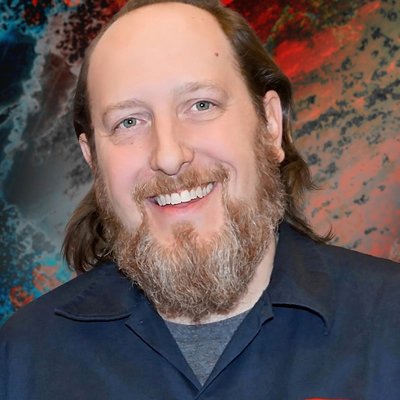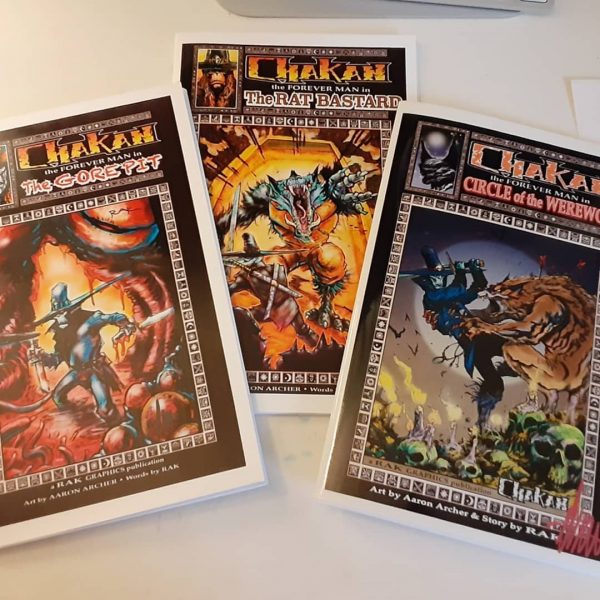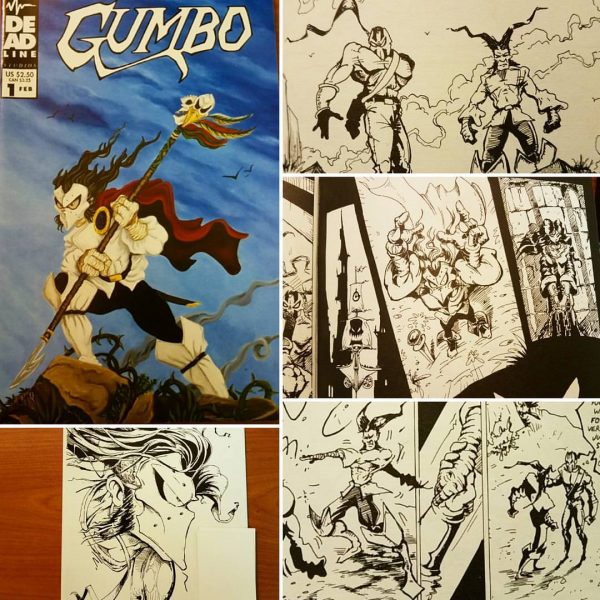Aaron Archer is a legend in the toy industry. Multiple skills and with an amazing reach of knowledge (as you are about to find out!), Aaron’s origins share connections with Robert Kraus’ RAK Graphics as we continue with our third part of a three-part interview.
PART TWO OF THREE-PART INTERVIEW: AARON ARCHER
Part one featured Robert Kraus • Part two: Rick Sellers
Joeseph Simon
My early memories of collecting action figures was that of the Micronauts. Many years later I would discover that Star Wars and GI Joe laid waste to the great toyline. What if Micronauts toys were able to hold on to their market and keep going? To me, it’s a shame that the innovations that Micronauts introduced to action figures were never capitalized on in America. Magnetic joins, interchangeable parts.
To me, Micronauts were the Beta tape of modern action figures. The original Micronauts was released by Mego via a license from Takara. Hasbro currently has the Micronauts license and is developing a film and or animated cartoon of the Micronauts. Having worked for Hasbro and Takara, what are your thoughts on my scenario?
Aaron Archer
It’s true that Micronauts was ahead of its time as a toy play concept and with a tie-in comic series but maybe a little early and missing a key ingredient, “Action entertainment” whether that is a movie or animated series. Mego had connections and with charismatic salesmanship, mentality made some great toys. However, the old toy world changed under their feet. The toy industry went from an old NY sales handshake type business to a corporate entertainment Licensing world very fast. Mego was caught in the middle and was overtaken by the wave of Star Wars, GI Joe etc.…
As for the quality or innovative play of Micronauts I have learned the hard way complexity and nuance play of a toy is not the primary reason a kid wants an item, they want to connect to a character or storyline as an avatar for their love of that larger franchise or world so the end of Mego Micronauts would not have ended any other way.
Joeseph Simon
Another “What If” is how the Micronauts would have evolved under Mego or even better yet, Hasbro? I believe it would not have been the same path as Takara’s Micromen. The American market and Hasbro likely would have steered the ship elsewhere.

Aaron Archer
Sure, hard to say but maybe we would be celebrating a 40 years old Micronaut (Microman in Japan) / Transformers-like concept, Instead of either of the two brands that exist now. You have to remember that Microman has a long history of content and product in Japan over the decades. Mego only brought over particular items from the line and added their own. Maybe Takara would have made a different deal with Hasbro that included Microman if there was never a Mego deal. So the world for GI Joe, Micronauts, and Transformers would be very different than today.
Joeseph Simon
I’ll even go one further, for the sake of interesting conversation in this interview. Takara’s Micromen were started in 1974 and I personally think they were far more ahead in innovation and design of action figures than anything in America. What are your thoughts on this statement? The later designs of Micromen as well as the Micromen designed Batman, Devilman and Gathaman figures were also amazing.
Aaron Archer
Absolutely Japanese toys of the ’60s and ’70s had amazing materials and play value, well and above anything made by American companies at the time. Those items were made in Japan, at their domestic industrial zenith. However, those materials and processes are expensive now or toxic in some way or not as reliable as toys need to be today, so great time to look back on.
Joeseph Simon
The Micromen, perhaps from the toy perspective, were proto-Transformers? If this is accurate, how did that happen? If not how did the Transformers begin and why did the Micromen end?
Aaron Archer
Well, the easy way to say it was that TF was a subline of Microman. That Sub-line Diaclone focused hard on accurate cars that turned into robots driven by little Micromen. The folks from Hasbro saw the transforming items from Takara and other Japanese makers and bought rights to a ton of molds, created a new story around those toy items and the rest is history…. Mego Micronauts deal was for particular items from Tamara’s Microman tooling catalog, it was not a blanket deal.
Joeseph Simon
I imagine the toy culture in Japan is quite different than here in America. Having worked for Takara, what differences did you see in the actual business of toy making and the consumers in Japan?
Aaron Archer
Space dictates what you can collect and how much of it, the commitment of the fans is amazing. Additionally, a kid here may be passively into a dozen or so properties, over there it is more focused and they go much deeper with it.
Joeseph Simon
 Takara eventually merged with its main competitor, Tomy. This was an interesting move. After, the merged company grew far bigger than what they could have alone. Takara is more than just the makers of the Micromen or Transformers. They are practically an industry unto themselves. How would you describe Takara to the readers?
Takara eventually merged with its main competitor, Tomy. This was an interesting move. After, the merged company grew far bigger than what they could have alone. Takara is more than just the makers of the Micromen or Transformers. They are practically an industry unto themselves. How would you describe Takara to the readers?
Aaron Archer
A very knowledgeable and dedicated company that worked hard to delight many audiences.
Joeseph Simon
Hasbro currently owns the Rom license. You left before Hasbro before that license was acquired Ever tried to design a Rom figure? Rom has a curious slice in action figure history. What is your take on the figure and the character?
Aaron Archer
My last few years at Hasbro was reviewing and internally developing internal properties. We had to see where we were with all the classic properties. Rebuilding Files, toy sample review, legal review, ownership rights, new opportunities, etc. ROM, MASK, Stretch Armstrong were all things I looked at during that time. As to your question ROM always had potential, Hasbro was looking where to use it.
Joeseph Simon
What action figures really got you to thinking about designing them? What non-Hasbro / Takara action figure lines have held your interest?
Aaron Archer
I was a Star Wars kid, I loved the Shogun Warriors, Early ZOIDS toys, but 82 GI Joe was my big one where I was into ALL of it.
Joeseph Simon
McFarlane Toys was another game-changer for the action figure industry. At one point, Spawn figures oversaturated the market. I’m curious about your take on the impact of Todd McFarlane on the toy industry.
Aaron Archer
This was a new era in the toy industry. Sculpting was elevated in those days by McFarlane and Art Asylum. Licensors wanted better-looking products after that. Toys have a lot of feature play and fun kid play over accuracy and articulation and paint. But the quality of those McFarlane toys hurt the industry for a bit too. Sometimes we have to parse out what is a toy when discussing McFarlane products. They carved out a unique space that continues to grow.
Joeseph Simon
Many creators think if only they could reach a bigger distribution, it would be a boon. In many ways, I think the bigger you get, the less innovative you can be. A company like Hasbro has an incredibly huge reach. To keep that reach they have to be able to sell in locations everyone else is envious of, compromises have to happen. If they don’t bad things happen for them. You lose your hold on the market and those places that you have distribution in start to not order your toys.
 You were very high up at Hasbro, now you’re freelance. You also worked with RAK’s Robert Kraus and other indie comic companies. Is there a middle ground between the big corporate structure and indie company that one can enjoy? Would that be, in fact, being freelance like you are?
You were very high up at Hasbro, now you’re freelance. You also worked with RAK’s Robert Kraus and other indie comic companies. Is there a middle ground between the big corporate structure and indie company that one can enjoy? Would that be, in fact, being freelance like you are?
Aaron Archer
Yes, like every industry, companies do not want a large payroll so rather than having the work done in-house they have outside talent do the work for a negotiated fee.
Joeseph Simon
In being a freelance creative, what is the best way for someone to have a foot in both worlds? To be able to approach large corporations and work with indie level companies?
Aaron Archer
A great portfolio online, constant output help set one up as a professional. Don’t be afraid to reach out in the proper ways online or at a convention to make an introduction. At the end of the day, I could hire anyone to make art, I needed people that understood how to deliver.

Joeseph Simon
Like Robert Kraus and Rick Sellers, you come from Northeast Ohio. More specifically, Canton. You also have, at a later stage of RAK Graphics, worked on Chakan, the Forever Man. You did the artwork for three Chakan graphic novellas and the packaging of the recently released Chakan action figure. Were you aware of RAK when Robert started the company in the ’80s? I imagine having a comic company in your general area was pretty cool.
Aaron Archer
It helped for sure. I went over to the “RAK house” as we called it 3-4 nights a week for about 2 years during college. I draw with other talented guys Wayne Losey, Chris Woods, Ben Torres all honing our skills and learning vibing from each other work. It’s like I took graduate-level classes at night during college.
Joeseph Simon
Today, we’re experiencing a creative explosion in all industries. On top of that creative explosion, various industries are crossing over into other industries. RAK’s expansion into video games, board games, action figures and more is an example of that. Rick Seller’s voice acting for voice cards, action figure voice chips, TV, radio are further examples. You have seen this the corporate level as the Creative Lead for all Transformers partnerships including four feature films, four video games, five animated series, theme park rides, and countless publishing projects.
I think it’s a great time for creators and the opportunities to cross over very interesting. I like seeing creators work together. Having worked on a variety of magazines and other projects, where people have to work together, I notice a lot of “pay attention to me” or “It’s my creation” that stifles creative people working together. As Creative Lead for Hasbro’s Transformers, you worked quite a lot of people. What advice would you give to creators finding themselves having to work with others in a creative way?
Aaron Archer
Well for me it was a lot about finding visual answers to business needs. So I worked with a range of outside/ freelance artists that helped me solve particular creative questions. If done correctly there is an open dialog and thick skin for all involved during the messy process of creation. It is important to work with people who understand the development process was key rather than just one awesome perfect image. There is a ton of rework and rushed timelines and that is before a licensor might weight in. Toy work generates a ton of ideas and concepts so it is hard to get too self-important.
Joeseph Simon
RAK Graphics, Rickard Seller’s Productions, and your work all have made inroads into licensing. Much like merchandising is important to bands, I think licensing is going to be more important to comic creators in the future. What advice do you have for comic creators?
Aaron Archer
Make things that matter to you and do it well. Don’t be derivative! Focus on telling a digestible story if you are hoping it to become something more than a comic book. Repeat!
Joeseph Simon
What are your thoughts on 3D printing and Vinyl Toy scene?
Aaron Archer
Cool forms are cool forms. It’s a fun scene but the best stuff is tough to find, so that limits the market to almost an art scene. But regardless if it is made by creators that believe in what they are putting out there it can be Art in toy form. I also think It is a reaction to 1) being surrounded by little plastic character toys and 2) wanting plastic character toys in a non-corporate form.
Joeseph Simon
As a designer, you have taken a 2d image and turned it into an action figure, an animated figure, a movie scene or even an amusement park ride. That’s pretty awesome. What is your background and what kind of background does a designer have to have to do such diverse and cool things?

Aaron Archer
My background is illustration, I learned a lot on the job to be a functioning industrial designer. I learned from the Kenner designers of the 70s—90s, great guys that shared much wisdom my way. I have always enjoyed how the matrix of all the promotion works around these things going back to Star Wars and GI Joe. So I came in as a designer but with all this childhood study of toys, character names, segmentation, tie-ins, cross-platform storytelling, collector clubs, commercials, mail-aways, and on and on set me up to understand how to make compelling brands at Hasbro. Said a different way, I could speak to Marketing in their own language.
Joeseph Simon
One last What If question: Do you miss Orson?
Aaron Archer
ORSON LIVES
JOESEPH SIMON
For more on Aaron check out archermonster.com.
This brings us to the end of this fun three-part interview. I’d like to thank Robert Kraus, Rick Sellers and Aaron Archer for being part of this three-part interview.
